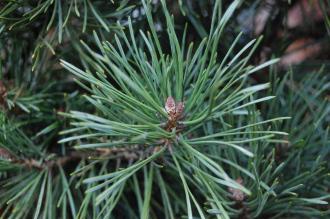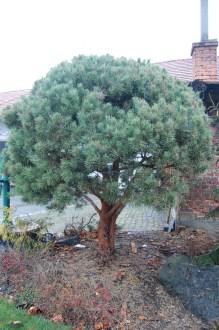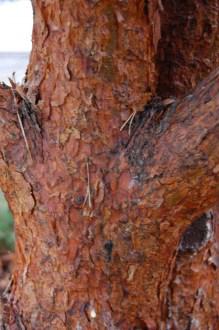
Pinus mugo subsp. mugo detail (26/12/2011, Belkovice, Czech Republic)
Position: Full sun to light shade
Flowering period: Late spring
Soil: light, well drained
Eventual Height: 6m
Eventual Spread: 4m
Hardiness: 3a – 10b
Family: Pinaceae
Pinus mugo subsp. mugo is a small, slow growing, evergreen, often multi stemmed, tree. Its bright green leaves are needle shaped, are bourne in pairs and are up to 7cm long. The branches are reddish in color and the trunk is red/ gray. This tree is monoecious, producing seperate male and female flowers. The wind pollinated female flowers produce cones that are nut brown and up to 5cm long. The seeds of this tree are spread by wind.

Pinus mugo subsp. mugo (26/12/2011, Belkovice, Czech Republic)
Pinus mugo subsp. mugo, commonly known as the Moutain Pine, Swiss Mountain Pine, Dwarf Mountain Pine or Mugo Pine, is native to high altitudes in south east Europe and is found in the Alps and other high elevations in south east Europe. P. mugo was introduced into parts of Denmark, Sweden and Norway as a pioneer and soil stabilisation species. Due to its ability to thrive in these locations it is now considered an alien species in these locations.
The etymological root of the binomial name Pinus is derived from the Latin name for Pine tree. Mugo is derived from an old Italian vernacular name for this tree.
The landscape architect may find Pinus mugo subsp. mugo as a small evergreen specimen tree. It may also be grown en mass as an impenetrable barrier. This tree is tolerant of the harshest of maritime climates. It is drought tolerant once established.

Pinus mugo subsp. mugo bark (26/12/2011, Belkovice, Czech Republic)
Ecologically P. mugo subsp. mugo provides good habitat for birds.
P. mugo subsp. mugo prefers a deep, well-drained soils. It tolerates most pH of soil, although it prefers chalky soils. It will tolerate poor soils.
P. mugo subsp. mugo requires little maintenance. New emergent growth may be pruned to produce a more dense growth habit.

